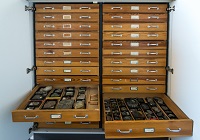Collections
Zoological Collection
 The nine research collections in the Museum of Nature - Zoology house more than ten million scientific objects. Together they form one of the most significant natural history museum collections in Germany. Founded in 1843 as the Hamburg Museum of Natural History, the Museum was later renamed the State Institute of Zoology and then the Zoological Museum Hamburg (ZMH) before it was finally incorporated into Universität Hamburg in 1969 and is now as the Museum of Nature - Zoology part of the Leibniz Institute for the Analysis of Biodiversity Change. [ more ]
The nine research collections in the Museum of Nature - Zoology house more than ten million scientific objects. Together they form one of the most significant natural history museum collections in Germany. Founded in 1843 as the Hamburg Museum of Natural History, the Museum was later renamed the State Institute of Zoology and then the Zoological Museum Hamburg (ZMH) before it was finally incorporated into Universität Hamburg in 1969 and is now as the Museum of Nature - Zoology part of the Leibniz Institute for the Analysis of Biodiversity Change. [ more ]
Mineralogical Collection
 The Museum of Nature - Mineralogy’s collection comprises around 90,000 objects, making it one of the largest of its kind in Germany. It also previously belonged to the Hamburg Museum of Natural History. The Museum’s extensive stock of reference collections forms the basis for training and research in the earth sciences. Its collection of meteorites—some 943 specimens from outer space, including several from the Moon and Mars .... [ more ]
The Museum of Nature - Mineralogy’s collection comprises around 90,000 objects, making it one of the largest of its kind in Germany. It also previously belonged to the Hamburg Museum of Natural History. The Museum’s extensive stock of reference collections forms the basis for training and research in the earth sciences. Its collection of meteorites—some 943 specimens from outer space, including several from the Moon and Mars .... [ more ]
Geological-Paleontological Collection
 The geological-paleontological collection originally belonged to the Hamburg Museum of Natural History and comprises around 100,000 objects. Some of these are of great regional significance, for example, the seventy-million-year-old fossils from the Lägerdorf chalk pit in Schleswig-Holstein and the archive for glacial erratics. The amber specimens and the extensive collection of fossilized cephalopods enjoy particular renown. [ more ]
The geological-paleontological collection originally belonged to the Hamburg Museum of Natural History and comprises around 100,000 objects. Some of these are of great regional significance, for example, the seventy-million-year-old fossils from the Lägerdorf chalk pit in Schleswig-Holstein and the archive for glacial erratics. The amber specimens and the extensive collection of fossilized cephalopods enjoy particular renown. [ more ]
Advice
The Leibniz Institute for the Analysis of Biodiversity Change is member of the Consortium of European Taxonomic Facilities. CETAF members are scientific, non-profit institutions in Europe. As a member, we commit ourselves to CETAF’S Code of Conduct & Best Practices on access to genetic resources and benefit-sharing in compliance with the Nagoya Protocol.

